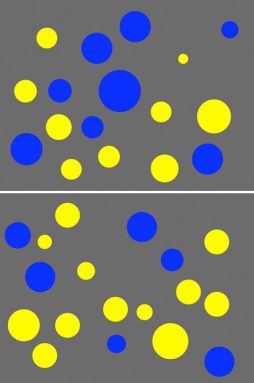Math and our number sense
Not all math skills are learned in the classroom. Some of them come naturally.
By Susan Gaidos
Not all math skills are learned in the classroom. Some of them come naturally. Consider the split-second calculations you make when you estimate the number of empty seats on the school bus or gauge the number of cookies in a cookie jar.
These ballpark estimates can often be done without counting. That’s because humans are born with the ability to approximate, or closely guess, the number of items in a group. Researchers refer to this trait as a person’s “number sense.”
Scientists have discovered that this inborn sense of numbers may influence learning and achievement in the classroom. Studies with teenagers show that students who excel at estimating quantities also did well on standard math achievement tests, going as far back as kindergarten.
These results suggest a “strong and significant relationship” between a person’s inborn number sense and his or her ability to learn mathematics in school, says psychologist Justin Halberda of Johns Hopkins University in Baltimore.
Researchers already knew that humans have a natural grasp of numbers. The ability to make rough approximations can be found in infants as young as 4 months old, and even in some animals. This inborn numerical sense reaches back millions of years, researchers say, and has been used by humans and animals to help guide everyday behaviors such as hunting for food.
But sometimes an approximation just won’t do. Most mathematical calculations carried out in the classroom and in day-to-day transactions require an exact number. To succeed in formal mathematics requires verbal reasoning, not to mention hours of homework and training.
To see how a person’s inborn, or intuitive, number sense might be linked to mathematical performance in the classroom, Halberda and his colleagues ran some tests.
 |
|
In a new study, 14-year-olds had a fraction of a second to identify the more numerous of two sets of colored dots, such as those in the images shown here. |
| Halberda |
The scientists asked 64 14-year-olds to look at images of yellow and blue dots that flashed on a computer screen for a fraction of a second. Each image contained between 10 and 32 dots that varied in size.
Some images contained twice as many blue dots as yellow dots. In other images, however, the number of blue and yellow dots was nearly equal. For each image, the students were asked to estimate which color had more dots.
The scientists found a wide variation in how well students could pick the color with the most dots. Some students could correctly approximate images with nearly equal numbers of dots. But others found it difficult to make such estimates, even when the ratio, the number of one color of dots compared to the number of another color of dots, wasn’t as close.
The scientists then looked at the students’ math scores dating back to kindergarten. Children that performed best in the image test also scored the highest in standard math achievement tests.
The same finding held true at the other end of the spectrum. Students who didn’t score well on the image test tended to receive lower math scores, even after factors, such as IQ levels, were taken into account.
The study was the first to show a link between a person’s inborn number sense and his or her achievement in formal math training.
Does this connection mean that one cannot be good in math if they have a weak number sense? Or that having a strong number sense is a guarantee for good grades in math? The answers are not clear.
While scientists continue looking at the possible links between a person’s number sense and math achievement, one thing is certain: Doing lots of math homework will boost your chances of success.
Going Deeper:







